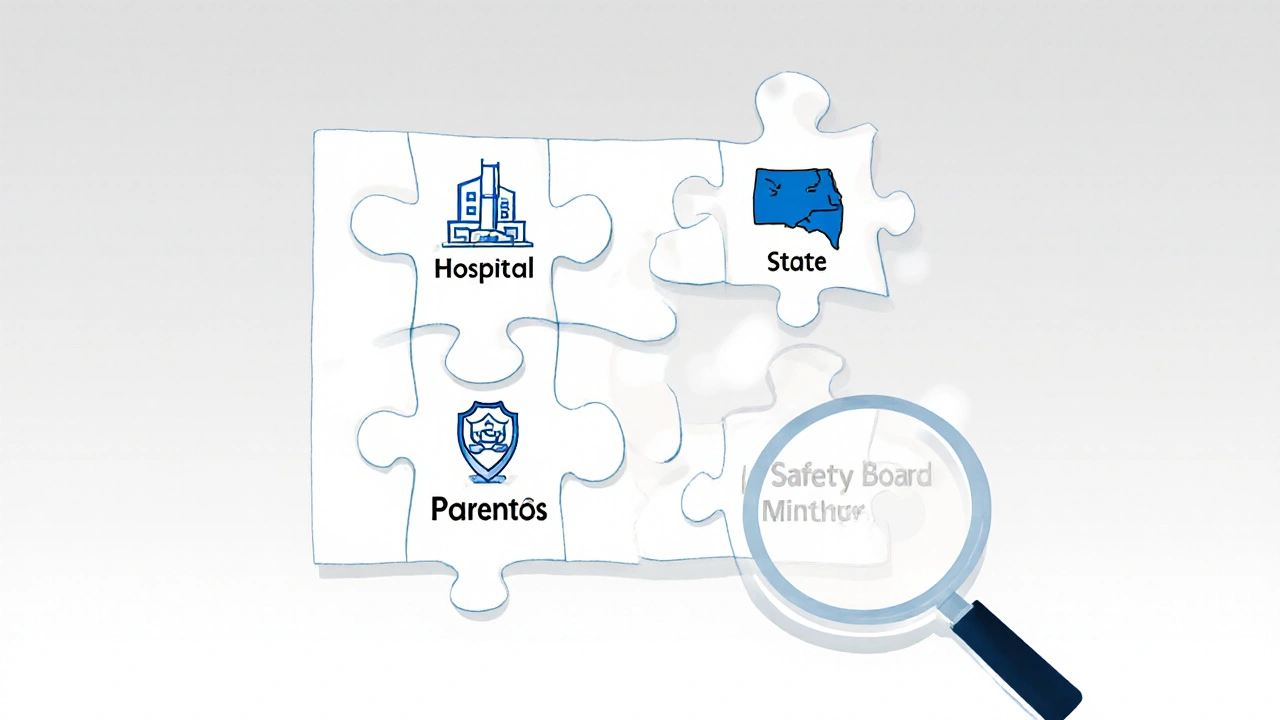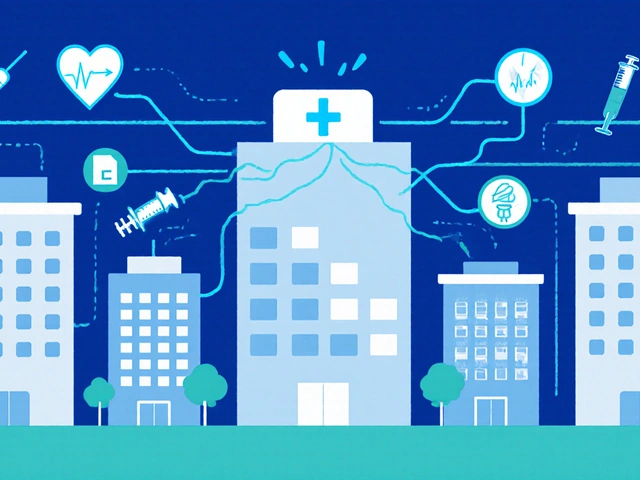Rare Side Effect Detection Calculator
This tool demonstrates why pediatric safety networks are essential for detecting rare side effects. Enter the expected incidence rate (e.g., 0.0002 for 1 in 5,000) and confidence level to see how many patients are needed to detect a rare event.
Estimated Patients Needed
This calculation shows the minimum number of patients required to have a 95% probability of detecting at least one case of a rare side effect. For context, CPCCRN pooled data from 7 hospitals to detect events affecting 1 in 5,000 children.
When a child is given a new medication or undergoes a complex treatment, doctors don’t always know what might go wrong. Rare side effects, delayed reactions, or unexpected interactions often don’t show up in small clinical trials. That’s where pediatric safety networks come in. These aren’t just research groups-they’re coordinated systems across hospitals and states, working together to catch problems that no single hospital could see alone.
Why Traditional Studies Fall Short for Kids
Most drugs tested for adults are given to children without proper safety data. Why? Because running large, controlled trials with kids is hard. Ethical concerns, small patient populations, and logistical hurdles make it nearly impossible to study rare side effects in one hospital. A reaction that happens in 1 out of 5,000 kids? You’d need dozens of hospitals working together to even notice it. That’s where networks like the Collaborative Pediatric Critical Care Research Network (CPCCRN) stepped in. Funded by the Eunice Kennedy Shriver National Institute of Child Health and Human Development (NICHD), CPCCRN brought together seven major children’s hospitals, a central data hub, and a dedicated safety board. Their goal? To study treatments for critically ill kids-and track every unexpected reaction, no matter how small.How These Networks Actually Work
These aren’t loose alliances. They’re tightly structured systems with clear roles. Each network has clinical sites that enroll patients, a Data Coordinating Center (DCC) that manages all the numbers, and formal oversight boards that watch for danger signs. At CPCCRN, every hospital followed the same protocols. When a child received a new treatment, doctors recorded every symptom, lab result, and vital sign using standardized forms. The DCC collected all this data in real time, running statistical checks to spot patterns. If three kids in different states developed the same unusual rash after a drug, the Data and Safety Monitoring Board would flag it immediately-even if each hospital had only seen one case. Meanwhile, the Child Safety Collaborative Innovation and Improvement Network (CoIIN), run by the Health Resources and Services Administration (HRSA), took a different approach. Instead of hospital-based drug monitoring, CoIIN focused on injury prevention. Teams in 16 states tracked things like car seat misuse, falls from windows, or unsafe sleep practices. They didn’t just collect data-they tested changes. One state noticed more teens were being injured in dating violence after launching a prevention program. They looked at the numbers, adjusted their training, and saw a drop in incidents within months.Key Differences: Clinical vs. Community Safety
Not all pediatric safety networks are the same. CPCCRN was built for the ICU. It could catch a sudden drop in blood pressure after a new antibiotic, or liver toxicity from a high-dose steroid. It worked with real-time clinical data-blood tests, heart monitors, ventilator settings. CoIIN worked in schools, clinics, and homes. Its data came from surveys, parent reports, and public health records. It tracked whether a new helmet law reduced head injuries, or if a community outreach program actually changed how parents stored medications. The big advantage of CPCCRN? Its ability to detect rare drug reactions. By pooling data from seven hospitals, they could spot side effects too rare for any one center to notice. CoIIN’s strength? Scaling proven safety changes across entire states. But neither could track long-term effects-like whether a child treated for sepsis at age 3 would develop learning issues at age 12. That’s still a gap.The Hidden Engine: Data and Governance
What made these networks work wasn’t just the hospitals. It was the infrastructure. The DCC didn’t just store data-it designed the tools. They created electronic forms that forced doctors to record side effects in the same way, no matter where they practiced. They ran sample size calculations so studies weren’t too small to detect risks. They even helped hospitals avoid underpowered analyses that could miss dangerous signals. Governance was strict. CPCCRN required every protocol to be approved by a Steering Committee and a Protocol Review Committee. The Data and Safety Monitoring Board had real power: they could pause a study if safety concerns arose. One unpublished report from a participating hospital said the DCC’s statistical support saved their study from failing because they’d initially planned to enroll too few kids. CoIIN had similar structure. Each state team had to use standardized worksheets to track outcomes. They met monthly, reviewed real-time dashboards, and adjusted their strategies based on what the data showed. One team working on sexual violence prevention realized their original approach wasn’t reaching at-risk teens. They added dating violence modules to their Green Dot program-and saw better results.Challenges and Lessons Learned
These networks weren’t easy to run. Hospitals had competing priorities. Some clinicians resisted adding extra paperwork to already overloaded schedules. CoIIN teams found that trying to tackle too many safety topics at once burned them out. In Cohort 2, most teams cut their focus from five areas to two or three. Data privacy was another hurdle. All networks had to meet HIPAA rules. CPCCRN used encrypted, centralized servers. CoIIN relied on state-level systems, which varied in security. Both required training for staff on how to handle sensitive information. Still, the benefits outweighed the headaches. Participating hospitals reported faster adoption of safer practices. One NICHD-funded study found that protocols developed through CPCCRN were implemented in non-network hospitals within two years-because the evidence was too strong to ignore.
The Bigger Picture: Why This Matters
Before these networks, children were treated like small adults. A drug safe for adults might cause seizures in a toddler. A car seat design that worked for a 5-year-old might fail for a 2-year-old. The lack of pediatric-specific safety data led to preventable harm. CPCCRN and CoIIN changed that. They proved that collaborative, data-driven safety monitoring works. Their models influenced later efforts like the Pediatric Trials Network, which continues today under NICHD. The lessons learned are now used in global pediatric research. The biggest takeaway? You can’t study rare side effects in isolation. You need scale. You need standardization. You need trust between institutions. And you need systems that don’t just collect data-but act on it.What’s Next for Pediatric Safety Research
The next wave of safety networks will connect hospital data with school records, pharmacy logs, and emergency room visits. Imagine a child who gets a new asthma medication, then has a reaction three weeks later. Right now, that link is hard to make. Future systems will automatically tie together prescriptions, hospital visits, and parent-reported symptoms across time and settings. Some researchers are already testing AI tools that scan clinical notes for unexpected symptoms-like a doctor mentioning "unusual fatigue" after a new drug. These tools, built on the foundation of CPCCRN and CoIIN, could flag risks before they become crises. The goal isn’t just to track side effects. It’s to prevent them before they happen. And that starts with networks that talk to each other.What are pediatric safety networks?
Pediatric safety networks are multi-hospital or multi-state collaborations designed to track and reduce side effects and injuries in children. They use standardized data collection, centralized analysis, and formal oversight boards to identify risks too rare for any single site to detect. Examples include the Collaborative Pediatric Critical Care Research Network (CPCCRN) and the Child Safety Collaborative Innovation and Improvement Network (CoIIN).
How do these networks detect rare side effects?
By pooling data from multiple hospitals or states, these networks can spot patterns that wouldn’t appear in small studies. For example, if three children in different cities develop the same unusual reaction after taking a new drug, the central data team can flag it-even if each hospital only saw one case. This is called multi-site surveillance, and it’s the only way to catch side effects that happen in 1 out of 1,000 or fewer patients.
What’s the difference between CPCCRN and CoIIN?
CPCCRN focused on drug and treatment side effects in critically ill children in hospital ICUs. It used clinical data like lab results and vital signs. CoIIN focused on preventing injuries like falls, car crashes, and abuse in community settings. It relied on surveys, public health records, and state-level policy changes. CPCCRN was hospital-based; CoIIN was community-based.
Are these networks still active today?
The original CPCCRN funding cycle ended in 2014, and CoIIN completed its second cohort in 2019. But their models live on. NICHD’s Pediatric Trials Network and other initiatives now use the same structure-centralized data, safety boards, multi-site collaboration. Many hospitals still follow protocols developed through these networks.
Why can’t we just use regular clinical trials for kids?
Traditional trials are too small and too slow for rare pediatric side effects. It’s also often unethical to randomly assign sick children to placebo groups. Safety networks don’t require randomization-they monitor real-world use. This lets researchers catch problems as they happen, without delaying care. They’re the only practical way to study safety in vulnerable, hard-to-recruit populations.
How do these networks protect patient privacy?
All networks follow HIPAA regulations. Data is de-identified-names, addresses, and exact birth dates are removed before being sent to central hubs. CPCCRN used encrypted, centralized servers. CoIIN relied on secure state-level systems. Staff received training on handling sensitive data, and access was restricted to authorized personnel only.
What impact have these networks had on child health?
They’ve led to safer treatments, faster policy changes, and better guidelines. For example, CPCCRN research influenced how antibiotics are dosed in critically ill children. CoIIN helped states revise car seat laws and childproofing standards after data showed unexpected risks. Many hospitals now use protocols developed through these networks as standard practice.



Johnson Abraham
November 11, 2025 AT 11:57Shante Ajadeen
November 12, 2025 AT 11:42dace yates
November 13, 2025 AT 12:36Danae Miley
November 14, 2025 AT 01:18Charles Lewis
November 15, 2025 AT 07:01Renee Ruth
November 16, 2025 AT 00:08Samantha Wade
November 16, 2025 AT 13:04Elizabeth Buján
November 18, 2025 AT 03:25Andrew Forthmuller
November 19, 2025 AT 17:04vanessa k
November 21, 2025 AT 01:08manish kumar
November 22, 2025 AT 14:00Nicole M
November 23, 2025 AT 09:00